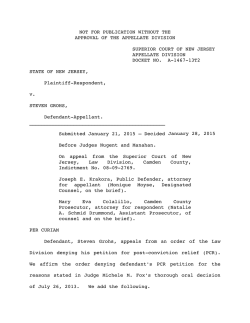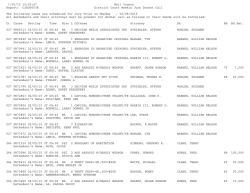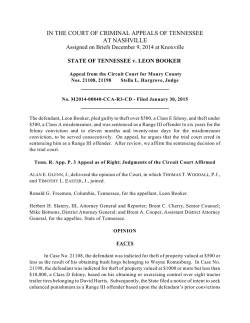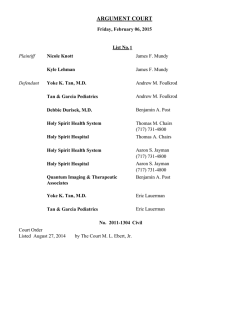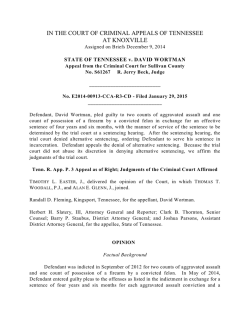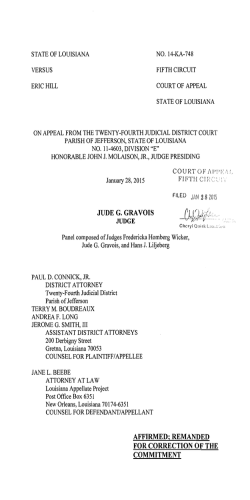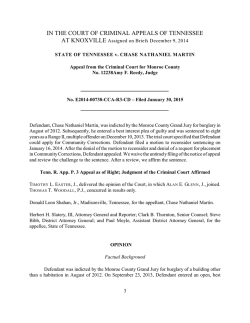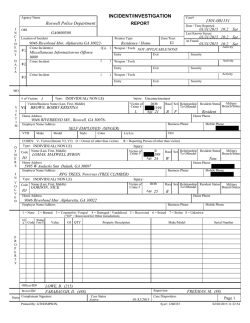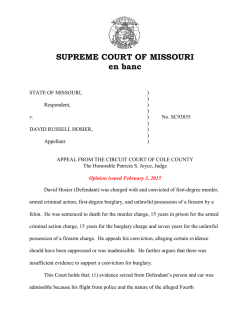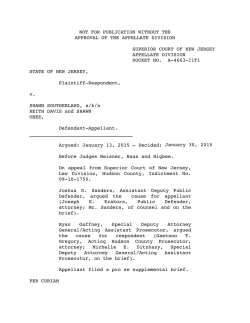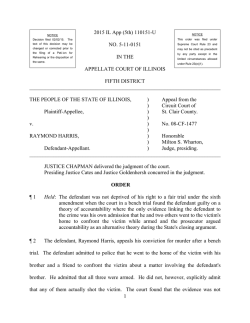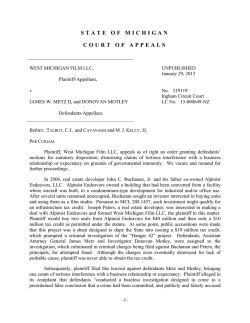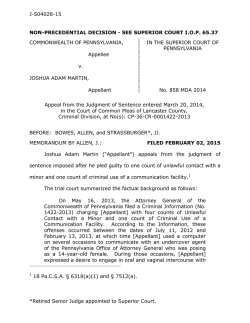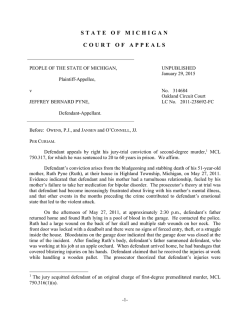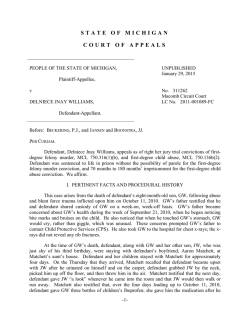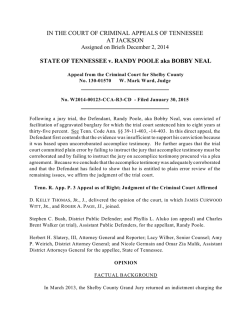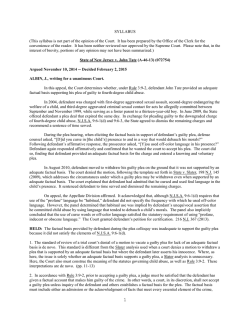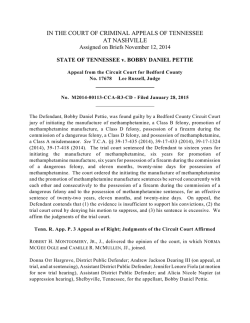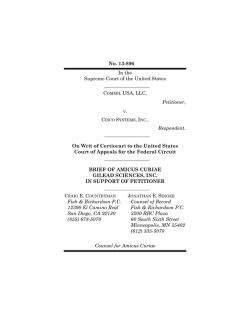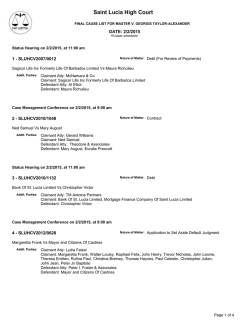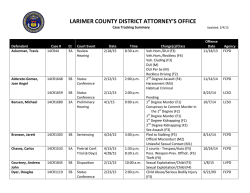
SUSAN M. CHEHARDY AFFIRMED - Fifth Circuit Court of Appeal
STATE OF LOUISIANA
NO. 14-KA-764
VERSUS
FIFTH CIRCUIT
MEKALE T. THOMPSON
COURT OF APPEAL
STATE OF LOUISIANA
ON APPEAL FROM THE TWENTY-FOURTH JUDICIAL DISTRICT COURT
PARISH OF JEFFERSON, STATE OF LOUISIANA
NO. 11-2499, DIVISION "L"
HONORABLE DONALD A. ROWAN, JR., JUDGE PRESIDING
COUI~T OF APP[~/\.J,
FIFTH CIf~CUIT
JANUARY 28,2015
FILED JAN 28 2015
(l/ 0')'/1 ~kM. ___
~~.~----
SUSAN M. CHEHARDY
CHIEF JUDGE
CLEF\I<
Cheryl Quirk LCllldri{)lI
Panel composed of Judges Susan M. Chehardy,
Robert A. Chaisson, and Robert M. Murphy
PAUL D. CONNICK, JR.
DISTRICT ATTORNEY
Twenty-Fourth Judicial District
Parish of Jefferson
TERRY M. BOUDREAUX
ANNE WALLIS
MYLES RANIER
JAMES MYERS
ASSISTANT DISTRICT ATTORNEYS
200 Derbigny Street
Gretna, Louisiana 70053
COUNSEL FOR APPELLEE,
THE STATE OF LOUISIANA
POWELL W. MILLER
Louisiana Appellate Project
Post Office Box 4121
New Orleans, Louisiana 70178
COUNSEL FOR APPELLANT,
MEKALE T. THOMPSON
AFFIRMED
~~rv'/
~
Defendant, Mekale T. Thompson, appeals from his conviction of second
degree murder and sentence of life imprisonment. For the reasons that follow, we
affinn his conviction and sentence.
PROCEDURAL HISTORY
On August 18,2011, a Jefferson Parish Grand Jury indicted defendant with
the second degree murder of Delast Francois. Defendant pled not guilty and the
matter proceeded to trial by jury on April 1, 2014. Following a three-day trial, the
twelve-person jury returned a verdict of guilty as charged. On May 2, 2014,
following the denial of defendant's motions for new trial and post-verdict
judgment of acquittal, the trial court sentenced defendant to life imprisonment at
hard labor without benefit of parole, probation, or suspension of sentence. This
timely appeal followed.
FACTS
At approximately 2:45 p.m. on the afternoon of April 27, 2011, Delast
Francois, the victim, and Kasee Thornton, his girlfriend, arrived in Ms. Thornton's
-2
vehicle at the house of Arthur Simmons at 2128 Huey P. Long Avenue in Gretna,
Louisiana. The victim was friends with Mr. Simmons' nephew, Chandrick
"Smurf" Harris,' who often visited his uncle and was there that day. Defendant,
who was also friends with Mr. Harris and the victim, was there too. When Ms.
Thornton and the victim arrived, they found defendant and "another guy" standing
on the front porch. Ms. Thornton remained in the vehicle while the victim exited,
proceeded to the front porch, and began to exchange words with defendant. Ms.
Thornton was unable to hear their conversation but soon observed the
confrontation become physical as the two men grappled and traded punches. At
this point, Mr. Harris exited the house and broke up the fight. Defendant then
retreated inside while the victim proceeded to the front porch of the neighbor's
house at 2130 Huey P. Long Avenue where he conversed with Joshua and Tedra
Carter.
Ms. Thornton called to the victim, telling him they should leave. He refused
and asked Ms. Thornton to open her trunk, in which she kept a baseball bat, but no
firearms. She did not observe the victim retrieve the bat or anything else from the
trunk, and watched as he returned to the neighbor's porch.
Five or ten minutes after defendant had left the scene, Ms. Thornton noticed
him reappear with a "fairly large rifle." At this point, he chased the victim around
the two houses and discharged the rifle four or five times. Ms. Thornton saw the
victim, who was bleeding, come from behind the houses running towards her when
he fell to the ground. Ms. Thornton called 9-1-1.
Several officers of the Gretna Police Department and EMS responded to find
the victim unresponsive. He was pronounced dead on the scene. A subsequent
I Chandrick Harris was murdered the next day, April 28, 2011, by Derrick Francois, the victim's brother.
Derrick Francois was convicted of second degree murder which this Court affirmed on appeal. See State v.
Francois, 13-616 (La. App. 5 Cir. 1/31/14), 134 So.3d 42, writ denied, 14-431 (La. 9/26/14), 149 So.3d 261.
-3
autopsy revealed that three gunshot wounds were the cause of death. At the
murder scene, officers located four 7.62 x 39 mm spent casings-two in the front
yard, two in the rear-and an AK-47 assault rifle stashed underneath a nearby
house. The rifle contained one round in the chamber and was loaded with a
magazine containing several more rounds. A trail of blood led around both houses.
Officers spoke with several eyewitnesses. Arthur Simmons explained that
he was inside when he was roused by the sounds of an argument outside. He
looked out the door to find the victim and defendant fighting and Mr. Harris
attempting to break it up. Mr. Simmons told them to leave and returned inside
after the fight ended. Several minutes later Mr. Simmons heard gunshots, but did
not observe anything further until the police arrived. He explained that he does not
own a gun and that he had never before seen the murder weapon in his house. He
also testified that there was blood on his front porch from defendant's eye which
had been injured in the fight with the victim. He identified defendant from a
photographic lineup as the person fighting with the victim shortly before the
gunfire.
Joshua Carter, who was familiar with the victim and defendant from the
neighborhood, explained that on April 27, 2011, he stepped onto his porch to
smoke a cigarette. His wife, Tedra Carter, who heard a "ruckus" outside, soon
joined him with their two-year-old nephew. As Mrs. Carter stepped outside, she
found the victim explaining to her husband that he had been fighting with
defendant over a bicycle. At this time Mr. Carter noticed Mr. Harris cleaning up
blood on the porch next door.
According to Mr. Carter, he spoke with the victim for approximately twenty
minutes before he observed defendant return with, as his wife described, a "big
gun." Defendant opened fire, the victim ran, and defendant gave chase. Mr. Carter
-4
hurried his wife and nephew inside and locked the door. He remained outside
where he heard the victim pleading with defendant: "You don't have to go this
far." From inside, Mrs. Carter heard the victim begging defendant to "chill out"
and then heard more gunshots.
Mr. and Mrs. Carter testified that they never saw the victim with a gun, a
bat, or any other weapon, nor did they observe blood on defendant's face. Mr. and
Mrs. Carter, as well as Ms. Thornton, identified defendant as the gunman from
photographic lineups.
A search warrant was obtained for defendant's house at 2121 Rose Drive in
Gretna, which is approximately three blocks away from the murder scene. The
search turned up one 7.62 x 39 mm round of ammunition in defendant's bedroom
which was consistent with the casings and weapon recovered from the scene. It
was also determined that the location from which the rifle was recovered is
between the murder scene and defendant's house.
Officer Jene Rauch, a firearm and toolmark examiner with the Jefferson
Parish Sherriff s Office Crime Lab and an expert in forensic firearm examination,
compared the four casings and the assault rifle recovered from the scene.
Although she was unable to definitively state that the four casings had been
discharged from the rifle, she also could not state that they had not been. She
further explained that the caliber of the rifle and the rounds found with it matched
the caliber of the four casings recovered from the scene.
Defendant turned himself in to the police on May 2, 2011. At trial, he took
the stand and admitted that he shot the victim. He explained that on April 27,
2011, he was on the porch with Mr. Harris and a third individual, "Chris," when
the victim arrived, proceeded onto the porch, and threw the first punch. During the
fight, the two men fell off the porch and the victim bit defendant's eye, obstructing
-5
t
his vision. Defendant freed himself and retreated into Mr. Simmons' house where
he retrieved the rifle, exited the back door, returned to the front of the house, fired
a shot, and then chased the victim around the two houses, discharging several more
rounds. Defendant stated that it took him one or two minutes to retreat into the
house, retrieve the rifle, and return outside. Defendant further testified that he was
"enraged" and "mad" and "wasn't thinking about nothing." He explained that he
would not have done it if he had not been so mad and stated that he was "sorry
about it."
DISCUSSION
In defendant's sole assignment of error on appeal, he argues that the
evidence was insufficient to support his conviction of second degree murder. He
contends that no rational trier of fact could have found guilt of second degree
murder beyond a reasonable doubt when the unrebutted evidence established the
elements of the lesser offense of manslaughter.
The question of sufficiency of the evidence is properly raised in the trial
court by a motion for post-verdict judgment of acquittal pursuant to La. C.Cr.P. art.
821. State v. Bazley, 09-358 (La. App. 5 Cir. 1/11/11),60 So.3d 7, 17, writ denied,
11-282 (La. 6/17/11), 63 So.3d 1039. Here, defendant filed a motion for post
verdict judgment of acquittal in which he argued the evidence supported only the
lesser offense of manslaughter, not second degree murder. Therefore, this
assignment of error is properly before us on appeal.
In reviewing the sufficiency of the evidence, an appellate court must
determine that the evidence, whether direct or circumstantial, or a mixture of both,
viewed in the light most favorable to the prosecution, was sufficient to convince a
rational trier of fact that all of the elements of the crime have been proven beyond
a reasonable doubt. Jackson v. Virginia, 443 U.S. 307,99 S.Ct. 2781, 61 L.Ed.2d
-6
560 (1979); State v. Neal, 00-674 (La. 6/29/01), 796 So.2d 649,657, cert. denied,
535 U.S. 940, 122 S.Ct. 1323, 152 L.Ed.2d 231 (2002); State v. Mickel, 09-953
(La. App. 5 Cir. 5/11/10),41 So.3d 532,534, writ denied, 10-1357 (La. 1/7/11),52
So.3d 885.
This directive that the evidence be viewed in the light most favorable to the
prosecution requires the reviewing court to defer to the actual trier of fact's rational
credibility calls, evidence weighing, and inference drawing. State v. Caffrey, 08
717 (La. App. 5 Cir. 5/12/09), 15 So.3d 198,202, writ denied, 09-1305 (La.
2/5/10), 27 So.3d 297. This deference to the fact finder does not permit a
reviewing court to decide whether it believes a witness or whether the conviction is
contrary to the weight of the evidence. Id. As a result, under the Jackson standard,
a review of the record for sufficiency of the evidence does not require the
reviewing court to determine whether the evidence at trial established guilt beyond
a reasonable doubt, but whether, upon review of the whole record, any rational
trier of fact would have found guilt beyond a reasonable doubt. State v. Jones, 08
20 (La. App. 5 Cir. 4/15/08), 985 So.2d 234, 240.
In making this determination, a reviewing court will not re-evaluate the
credibility of witnesses or re-weigh the evidence. Caffrey, supra. Indeed, the
resolution of conflicting testimony rests solely with the trier of fact, who may
accept or reject, in whole or in part, the testimony of any witness. See State v.
Bailey, 04-85 (La. App. 5 Cir. 5/26/04), 875 So.2d 949,955, writ denied, 04-1605
(La. 11/15/04), 887 So.2d 476, cert. denied, 546 U.S. 981, 126 S.Ct. 554, 163
L.Ed.2d 468 (2005). Thus, in the absence of internal contradiction or
irreconcilable conflicts with physical evidence, the testimony of one witness, if
believed by the trier of fact, is sufficient to support a conviction. State v. Dixon,
-7
07-915 (La. App. 5 Cir. 3/11/08),982 So.2d 146,153, writ denied, 08-0987 (La.
1/30/09), 999 So.2d 745.
In the instant case, defendant was charged with and convicted of second
degree murder, a violation of La. R.S. 14:30.1. Second degree murder is defined,
in pertinent part, as the killing of a human being when the offender has a specific
intent to kill or to inflict great bodily harm. See La. R.S. 14:30.1(A)(1). Specific
intent is that state of mind which exists when the circumstances indicate that the
offender actively desired the prescribed criminal consequences to follow his act or
failure to act. State v. Seals, 09-1089 (La. App. 5 Cir. 12/29/11),83 So.3d 285,
306, writ denied, 12-0293 (La. 10/26/12),99 So.3d 53, cert. denied, --U.S.--, 133
S.Ct. 2796,186 L.Ed.2d 863 (2013) (citing La. R.S. 14:10(1)). The determination
of specific intent is a question of fact. Id., 83 So.3d at 306. Specific intent may be
inferred from the circumstances and from the defendant's actions; and the intent to
kill or to inflict great bodily harm may be inferred from the extent and severity of
the victim's injuries. Id. Further, a specific intent to kill may be inferred from the
intentional use of a deadly weapon such as a knife or gun. State v. Cochran, 09-85
(La. App. 5 Cir. 6/23/09), 19 So.3d 497, 508, writ denied, 09-1742 (La. 3/26/1 0),
29 So.3d 1249; see also State v. Gonzalez, 07-449 (La. App. 5 Cir. 12/27/07),975
So.2d 3, 8, writ denied, 08-0228 (La. 9/19/08), 992 So.2d 949 ("The act of aiming
a lethal weapon and discharging it in the direction of the victim supports a finding
by the trier of fact that the defendant acted with specific intent to kill.").
In addition to proving each statutory element of the crime charged, the State
must also prove the identity of the perpetrator. State v. Williams, 08-272 (La. App.
5 Cir. 12/16/08),3 So.3d 526,529, writ denied, 09-0143 (La. 10/16/09), 19 So.3d
470. Thus, in order to carry its burden of proof, the State is required to negate any
-8
reasonable probability of misidentification. Id. Positive identification by only one
witness is sufficient to support a conviction. Id.
In the instant case, the evidence adduced at trial was clearly sufficient for
any rational trier of fact to have found defendant guilty of second degree murder
beyond a reasonable doubt. Three eyewitnesses-Ms. Thornton, and Mr. and Mrs.
Carter-testified that they observed defendant shoot the victim. Plus, defendant
himself admitted to shooting the victim. From this, we conclude that any rational
trier of fact would have found beyond a reasonable doubt that defendant acted with
the specific intent to kill or to inflict great bodily harm.
Our inquiry does not end here, however, because defendant argues that the
evidence supported the lesser offense of manslaughter where he shot the victim in
a sudden passion or heat of blood.
Manslaughter is defined as a homicide that would be a first or second degree
murder, except that the offense is committed in a sudden passion or heat of blood
immediately caused by a provocation sufficient to deprive an average person of his
self-control and cool reflection. See La. R.S. 14:31(A)(1). Provocation shall not
reduce a homicide to manslaughter if the jury finds that the offender's blood had
actually cooled, or that the average person's blood would have cooled, at the time
the offense was committed. Id. "Sudden passion" and "heat of blood" are not
elements of the offense of manslaughter; rather, they are mitigatory factors that
may reduce the grade of the offense. State v. Bauman, 08-1169 (La. App. 5 Cir.
5/12/09), 15 So.3d 177, 185, writ denied, 09-1533 (La. 5/23/10),34 So.3d 300.
In order to be entitled to the lesser verdict of manslaughter, the defendant is
required to prove the mitigatory factors by a preponderance of the evidence.
Bauman, supra. Provocation and time for cooling are questions for the jury to
determine under the standard of the average or ordinary person, one with ordinary
-9
self-control. Id. The question for this Court on review is whether a rational trier of
fact, viewing the evidence in the light most favorable to the prosecution, could
have found that the mitigatory factors were not established by a preponderance of
the evidence. Id.
Defendant contends that the victim's biting his eye deprived him of his self
control and cool reflection, provoking him to shoot Delast Francois in a sudden
passion or heat of blood. In assessing a charge of manslaughter, the trier of fact
must consider the following two questions. Was the claimed provocation
sufficient to deprive an average person of his self-control and cool reflection? And
was there sufficient time between the claimed provocation and the hot-blooded
action such that defendant's blood had actually cooled, or that the average person's
blood would have cooled?
As to the first question, there was inconsistent testimony regarding
defendant's eye injury. Mr. Simmons testified the blood on his front porch
originated from defendant's eye injury. And although Mr. Carter testified that he
observed Mr. Harris cleaning up blood on the porch, both he and his wife stated
that they did not observe blood on defendant's face. Defendant's booking
photographs, taken five days after the incident, depict a scabbed wound on his right
eyebrow. As to the second question, there was conflicting testimony regarding the
duration between the provocation and defendant's hot-blooded action. Defendant
testified that one or two minutes elapsed; Mr. Carter testified twenty minutes; and
Ms. Thornton testified five or ten minutes.
The resolution of this inconsistent and conflicting testimony rested solely
with the trier of fact; and in finding defendant guilty of second degree murder, the
jury evidently resolved these questions in favor of the State and against defendant.
We will not re-evaluate the credibility of witnesses or re-weigh the evidence.
-10
Therefore, viewing this evidence in the light most favorable to the prosecution, we
conclude that any rational trier of fact could have found that the mitigatory factors
were not established by a preponderance of the evidence.
This assignment of error is without merit.
ERRORS PATENT
The record was reviewed for errors patent, according to La. C.Cr.P. art. 920;
State v. Oliveaux, 312 So.2d 337 (La. 1975); and State v. Weiland, 556 So.2d 175
(La. App. 5 Cir. 1990). No errors patent were found in this case.
DECREE
For the foregoing reasons, defendant's conviction of second degree murder
and his sentence of life imprisonment are affirmed.
AFFIRMED
-11
SUSAN M. CHEHARDY
CHERYL Q. LANDRIEU
CHIEF JUDGE
CLERK OF COURT
MARY E. LEGNON
FREDERICKA H. WICKER
JUDE G. GRAVOIS
MARC E. JOHNSON
ROBERT A. CHAISSON
ROBERT M. MURPHY
STEPHENJ. WINDHORST
HANS J. LIUEBERG
JUDGES
CHIEF DEPUTY CLERK
SUSAN BUCHHOLZ
FIRST DEPUTY CLERK
FIFTH CIRCUIT
MELISSA C. LEDET
101 DERBIGNY STREET (70053)
DIRECTOR OF CENTRAL STAFF
POST OFFICE BOX 489
GRETNA, LOUISIANA 70054
(504) 376-1400
(504) 376-1498 FAX
www.fifthcircuit.org
NOTICE OF JUDGMENT AND
CERTIFICATE OF DELIVERY
I CERTIFY THAT A COPY OF THE OPINION IN THE BELOW-NUMBERED MATTER HAS BEEN
DELIVERED IN ACCORDANCE WITH Uniform Rules - Court of Appeal, Rule 2-20 THIS DAY JANUARY
28.2015 TO THE TRIAL ruDGE, COUNSEL OF RECORD AND ALL PARTIES NOT REPRESENTED BY
COUNSEL, AS LISTED BELOW:
"
/
I
I I; (l, ';!/YY /'
\j~J~~Y{~;:::E~c~
rt
oi ,
CLERK OF COURT
14-KA-764
E-NOTIFIED
POWELL W. MILLER
TERRY M. BOUDREAUX
ANNE M. WALLIS
MAILED
HON. PAUL D. CONNICK, JR.
DISTRICT ATTORNEY
MYLES RANIER
JAMES MYERS
ASSISTANT DISTRICT ATTORNEYS
TWENTY-FOURTH JUDICIAL DISTRICT
200 DERBIGNY STREET
GRETNA, LA 70053
./
© Copyright 2025
